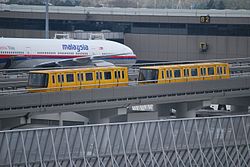This article needs additional citations for verification .(August 2014) |


Otis Hovair Transit Systems is a type of hovertrain used in low-speed people mover applications. Traditional people mover systems used wheeled vehicles propelled by electric motors or cable traction. The Hovair replaces the wheels with a hovercraft lift pad. The aim is to reduce guideway complexity and vehicle maintenance. Another benefit is the system's ability to move in all directions, including sideways. The Hovair is the only hovertrain system to be used in commercial service.